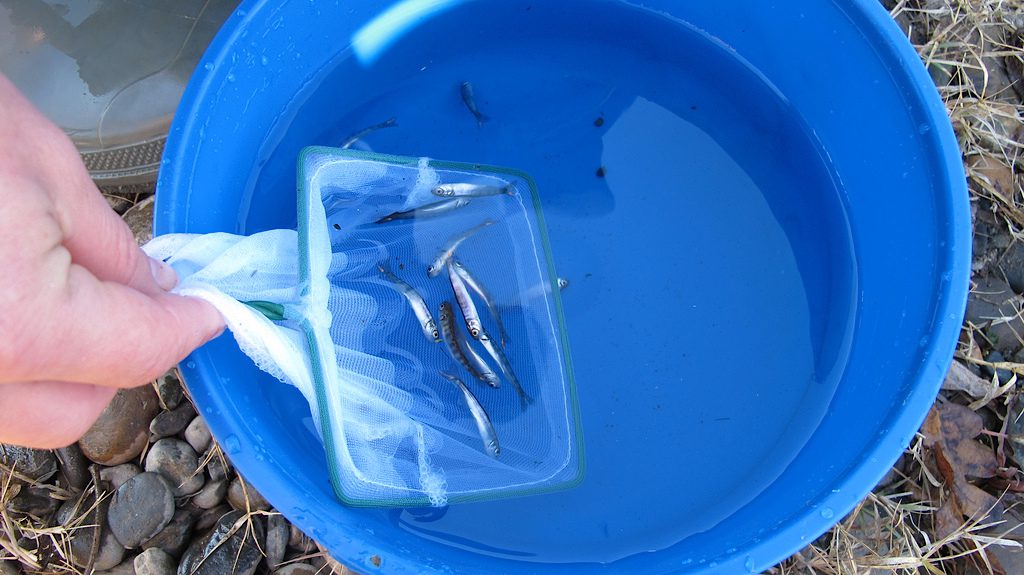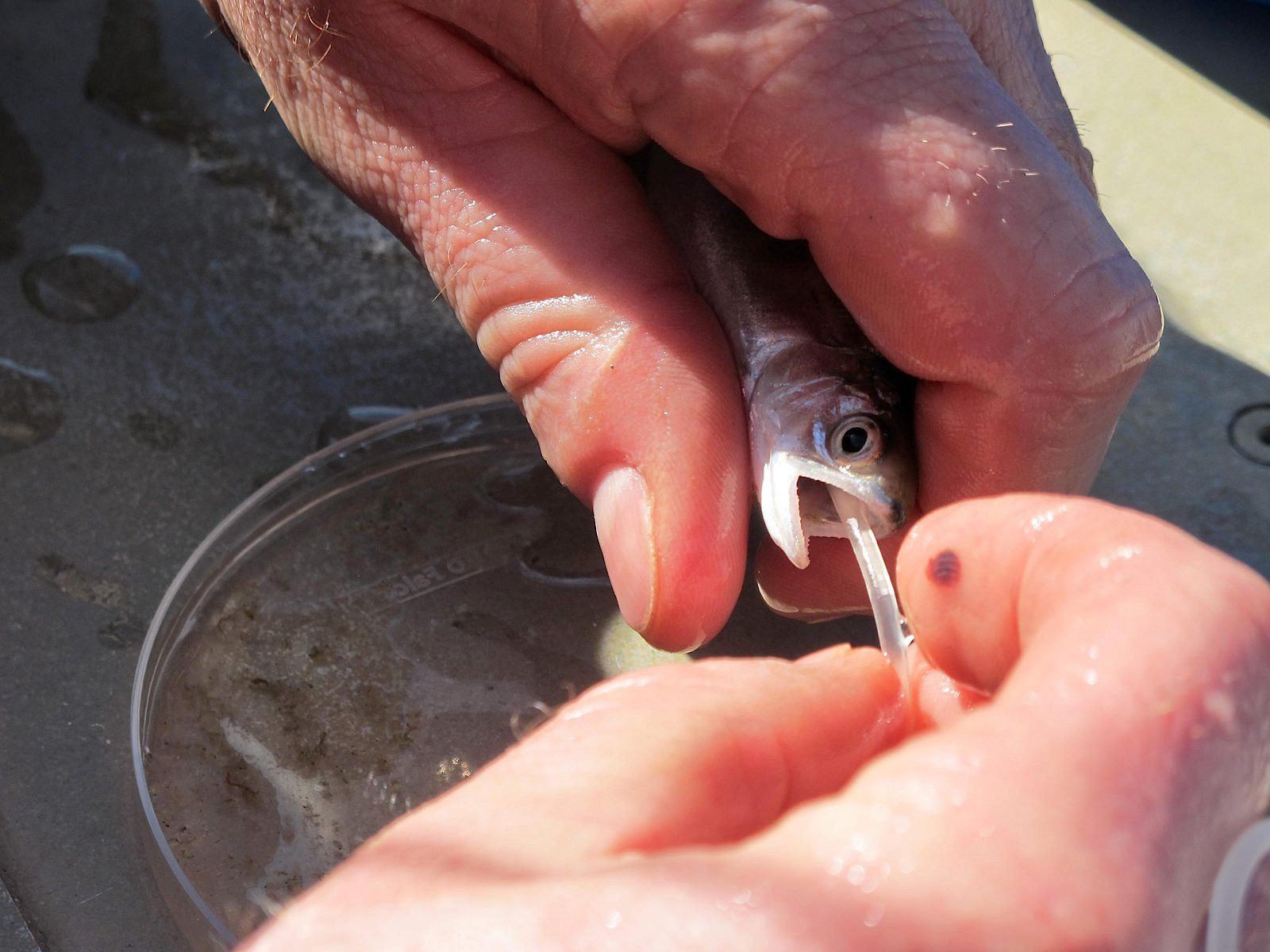Monday February 17, 2014
 Handling fish is an integral activity when it comes to conducting fisheries studies, and is therefore a daily part of our work. Studying fish entails measuring and weighing them, collecting scales from some, performing gastric lavage on others, and attaching or surgically implanting tags in a few. For most of these procedures, the use of sedatives is essential to minimize stress, facilitate handling, and reduce the risk of injury to the fish. The Federal Food and Drug Administration (FDA) strictly regulates the use of chemical sedatives administered to fish that may be consumed by humans, and the California Department of Fish and Wildlife (CDFW) approves methods of fish sedation or anesthesia occurring within the state. Until recently, the only FDA-approved sedative was tricaine methanesulfonate, known as MS-222. However, CDFW recently advised researchers that the use of this tried-and-true substance is no longer permitted for research specimens intended for immediate release – leaving many researchers in a search for alternatives.
Handling fish is an integral activity when it comes to conducting fisheries studies, and is therefore a daily part of our work. Studying fish entails measuring and weighing them, collecting scales from some, performing gastric lavage on others, and attaching or surgically implanting tags in a few. For most of these procedures, the use of sedatives is essential to minimize stress, facilitate handling, and reduce the risk of injury to the fish. The Federal Food and Drug Administration (FDA) strictly regulates the use of chemical sedatives administered to fish that may be consumed by humans, and the California Department of Fish and Wildlife (CDFW) approves methods of fish sedation or anesthesia occurring within the state. Until recently, the only FDA-approved sedative was tricaine methanesulfonate, known as MS-222. However, CDFW recently advised researchers that the use of this tried-and-true substance is no longer permitted for research specimens intended for immediate release – leaving many researchers in a search for alternatives.
Fisheries research isn’t the only application for fish sedation: it’s also used for the transport and processing of live fish for aquaculture and the aquarium trade to reduce stress and minimize fish mortality or injury. Sedated fish experience a decreased metabolic rate, so can be transported at higher densities to markets or for stocking purposes. Aquaculture operations often sedate fish prior to harvest, a practice referred to as “rested harvest,” which minimizes stress-induced lactic acid buildup and consequently improves the color, appearance, texture and consistency of the food product (Bosworth et al. 2007). A variety of fish sedatives are known, and some natural products that are widely available, such as clove oil, are popular with aquarists. However, fisheries researchers and the aquaculture sector typically rely on commercial products specifically manufactured for the purpose of fish sedation or anesthesia.
 Sedatives are subject to extensive testing before FDA approval for use in fish intended for consumption. While clove oil can be used in dental cement or food additives, neither clove oil nor any of its components are regarded as safe for use as a fish anesthetic until further tests prove conclusive. The FDA has approved the use of MS-222 for fish intended for consumption, with the stipulation of a 21-day withdrawal period before fish can be harvested and consumed. While such a withdrawal period is impractical for some management tasks (such as stocking purposes), research activities in California that involve species or specimens not subject to human consumption have typically relied on the use of MS-222 for sedation.
Sedatives are subject to extensive testing before FDA approval for use in fish intended for consumption. While clove oil can be used in dental cement or food additives, neither clove oil nor any of its components are regarded as safe for use as a fish anesthetic until further tests prove conclusive. The FDA has approved the use of MS-222 for fish intended for consumption, with the stipulation of a 21-day withdrawal period before fish can be harvested and consumed. While such a withdrawal period is impractical for some management tasks (such as stocking purposes), research activities in California that involve species or specimens not subject to human consumption have typically relied on the use of MS-222 for sedation.
However, it’s not easy to determine whether a fish encountered in the field may actually end up on someone’s dinner plate. One might assume that the 21-day withdrawal period is not a concern for fishes that are illegal to harvest, and therefore consume, such as wild rainbow trout/steelhead in anadromous waters of the Central Valley, or Chinook salmon fry and juveniles. However, there are multiple accounts of anglers proudly delivering telemetry tags from protected fish to a local CDFW office – tags discovered while preparing their catch for the frying pan. Such incidents illustrate that even protected fish may occasionally be consumed.
The CDFW announced that the recent ban on MS-222 is intended to protect the health of “those that may unknowingly consume [MS-222] through capturing fish and wildlife for use as food.” The only remaining alternative fish sedative for research that does not require additional approval is carbon dioxide, for which it is often difficult to determine, achieve, and maintain a proper dosage for fish sedation. This recent change in regulations has researchers throughout the state scrambling for other options to replace MS-222 and continue with their scheduled research activities. The FDA has granted authorization for the immediate release of fishes sedated with Auqi-S® in field applications, though under strict stipulations including time-consuming and costly approval, registration, and detailed reporting. Although far from a quick and easy solution, we hope that this authorization is an important step towards finding an appropriate sedative that is safe for the specimen under study, the researchers that use it, and those who catch and eat protected fish.
